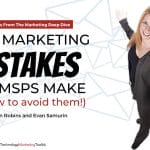It’s inevitable that you’ll be sending an email to leads, clients and prospects as part of your marketing. To make sure you have the most success in getting them to respond, be aware of the following items.
1. Who The Email Is Coming From
- Make it a person, not a company.
Do not send it from your company’s generic email, like [email protected]. You need to make sure it’s from a person and that it’s always from the same person. A mistake companies will make is sending an email from different people.
- Your relationship with the person receiving the message is critical
Some of you may have experienced this. You’re about to opt-out of an email and then you realize, “Oh, wait a minute, I do business with this company. I actually like this company; I just didn’t recognize the person.”
This is why it has to be consistently sent from the same person. The relationship with the person who is receiving it is going to determine if they open it. When you’re looking at your email, you’re basically looking at the From and the subject line. You’re either hitting delete, delete, delete, or you might be opening it.
It’s like what Gary Halbert, one of the world’s greatest copywriters, said back in the day. Gary talked about how America sorts its physical snail mail over the trash. Some of you may still do this. You get the mail, walk in, and stand over the trash can. What are you doing? You’re sorting the mail. Based on what? Envelopes. You’re like, “This is clearly a postcard and I’m not interested in it.” There’s an A pile and a B pile. Email is the same thing.
The who is the person that it’s coming from, and the subject line is the envelope. In other words, if they don’t recognize who you are and the subject line doesn’t pique their curiosity, you’re going in the trash. Maybe they’ll opt out but more often than not, they’ll send it to the junk folder.
2. The Subject Line
- Teaser copies or ambiguous statements work best
I’ll give you another direct mail analogy. How many of you get the envelopes from the bank that say “New credit card, 0% interest” then think, “I’m not interested”? Very few people are, and the envelope is what gave it away. So what do you do? You throw it away. The subject line is the envelope. If there is a little uncertainty or they are not sure what it is, you’ll actually have a better chance of getting it opened.
- Avoid capitalizing the first letter of every word
Think of it like you’re writing an email to a friend. Most of you, when you’re writing an email, end up sitting down and writing an advertisement-style email that will go to a group of people. The communication in these types of emails sound different. They start to sound like a corporate brochure.
What you want is for it to sound like you just fired off a quick email to a friend. That will get you the better response. If I’m just firing off a quick email, I am not going to capitalize the first letter of every word in the subject line, nor am I going to put “Here’s your newsletter.” Again, it’s the envelope basically saying what it is. Rather do something a little bit more curious and put “The one trick that’ll get all your emails opened” or something that raises curiosity in the subject line.
One of our best-performing subject lines is just the word Hey. H-e-y. Another one is if we put their first name in the subject line. A little twist on that is writing For and including their name. Writing this in the subject line doesn’t really say what it’s about but they’ll see their first name and it will get them to at least read the email. The subject line is not going to sell anything, but it’s also not giving everything away.
The subject line is just to get them to stop and take a look.
3. Your Copy/Offer
Make sure your copy has an offer and make it look like a personal email. Write it as though you’re writing to one person and not a group. If there is a link, you want to put it above the fold and make sure there is some sort of call to action or response included.
Also, make sure you provide the next steps that you want them to do. Do you want them to “click here” and fill in a form to request an appointment?, Do you want them to “click here” and download a report? or Do you want them to call your office? You have to give the next step in action.
Most marketing I see has no clear instructions on what the next step is for that prospect.
If you don’t give them the next step, they won’t do it. Then you don’t get the appointments, you don’t get the opt-ins, and you don’t get the opportunities. It’s Direct Response Marketing 101. You have to tell the prospect, “Here’s what I want you to do. Are you with me?”
“Yes.”
“Okay, good!”



